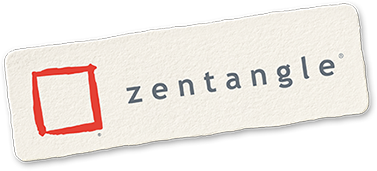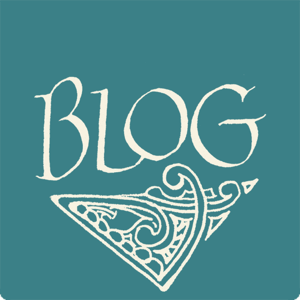In this Zentangle Blog Series we explore the ins and outs of some of our most loved Tangles. Join us as we journey back to how it was discovered and deconstructed, why a certain tangle got its name, and who was involved in the process. We will look into different styles, applications and tangleations of a tangle. We will examine how some tangles have evolved over time and discuss how the same patterns have multiple names. Some tangles have inspired tangleations that were so wonderful that they became their own tangle. This series is fun deep dive into the life of a tangle.
Today, we take a look at the tangle hollibaugh. Enjoy!
---+---
Molly writes...
When we talk about teaching the Zentangle Method, we often start with a few very simple foundational techniques. Of those techniques, there is one that I believe really empowers an artist to create depth and dimension in their tangled artwork. We call this technique, “drawing behind”. The best way to teach and learn “drawing behind” is with the tangle, hollibaugh.
Hollibaugh was one of the early tangles added to our collection of tangles. It was shared with us by a dear friend of the Zentangle family, Nick Hollibaugh. People often share patterns with us. Not all of them are tangles. If we look at the pattern and can see that it can be drawn with a few simple steps using elemental strokes, then we decide to share it as a tangle. We give tangles names to give them an identity and so that we can reference it. We do not trademark tangles. And very often there are similar or even identical patterns that have different names or step-outs because multiple people have discovered, deconstructed and named them. We welcome and embrace this part of the world of tangles.
Nick shared with us this pattern that he drew often when he was in middle school. He would cover posters and add it to backgrounds in his drawings. He was always “drawn” to very straight lines and geometric shapes. These early drawings became obvious influences in his artwork as he matured.

We were eager to add hollibaugh to our bank of tangles because it offered wonderful, unexpected results and also shared this magical technique that tanglers could then incorporate into other tangles. Once you can imagine how your strokes and shapes can layer like the boards of hollibaugh do, you can create more depth and dimension to all your tangled compositions.
Hollibaugh, also demonstrates that a tangle does not have to be predictable and uniform. Hollibaugh may seem random and chaotic but it actually follows a specific sequence. It is bold and dynamic and very recognizable. When I see hollibaugh randomly drawn somewhere, I always take a second glance as there is a good chance the artist has a Zentangle connection.
--- + ---
Thank you all who shared your one-word descriptions of the Zentangle Method on our last blog. We have randomly selected Vreni Murphy to receive a special Zentangle Surprise!
And, thank you to everyone who uploaded their first tiles to the Zentangle Mosaic app with the hashtag #humblebeginnings. We have randomly selected @JillMcD to receive a Zentangle Surprise.
If you are just joining us, we have been going Back to Basics these past couple of weeks as we get ready to share something new and exciting with you! Be sure to check out the other posts in this series here.



It always brought such drama & dimension to each one. I haven’t played with it recently, so thanks for the reminder! 🤗
~Jan~ Sailandbejoyful on
MaryAnn Scheblein-Dawson, CZT#1 on
Hollibaugh has always been my “Mac and Cheese” tangle. When in doubt Hollibaugh can function as string or reticula.
I feel like it is always in my back pocket.
Deb Murray CZT30 on
Hollibaugh is always part of my Introduction to Zentangle workshops. It is a tangle that very often delights the 1st time tangler and gives them the confidence to draw more using the Zentangle Method. For me it is definitely one of my “Mac & Cheese” tangles.
Bette Abdu, CZT on
This has always been one of my favorite tangles!!
Linda Hunter CZT31 on
Maria Vennekens on
Jane E Laine on
Hollibaugh is the most versatile tangle for me. I rarely draw it with straight lines and unadorned. Really, it’s a peach of a tangle and super fun to dress up too!
Kathy Y. on
Lynda Moore on
I also love Hollibaugh because it can be straight, curved, or angled. Then of course it calls for fragments to be added sometimes. It’s versatile.
Lori Riden on
Hollibaugh is the tangle I think of to sum up the whole process of tangling – one step at a time & that going behind that seems to exist on every single tile somehow.
Evy Browning on
I love Hollibaugh as it can be as simple or complex as you want.
Jackie on
Jessica Dykes on
Learning Hollibaugh has been great crossover training for my other art works. I had always had trouble drawing grid or grill type structures until I learned Hollibaugh. After I learned it I was painting a scene with a gate at my grandmas farm and left the gate to the end when I suddenly realized that the wooden gate was an example of Hollibaugh at work! It turned out beautifully thanks to Hollibaugh! Thanks!
Sandy Kelley-Jones CZT on
Missy Keller on